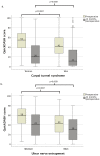Socioeconomic Differences between Sexes in Surgically Treated Carpal Tunnel Syndrome and Ulnar Nerve Entrapment
- PMID: 36417243
- PMCID: PMC9620911
- DOI: 10.3390/epidemiologia3030027
Socioeconomic Differences between Sexes in Surgically Treated Carpal Tunnel Syndrome and Ulnar Nerve Entrapment
Abstract
We aimed to investigate socioeconomic differences between sexes and the influence on outcome following surgery for carpal tunnel syndrome (CTS) or ulnar nerve entrapment (UNE) at the elbow. Patients with CTS (n = 9000) or UNE (n = 1266) registered in the Swedish National Register for Hand Surgery (HAKIR) 2010-2016 were included and evaluated using QuickDASH 12 months postoperatively. Statistics Sweden (SCB) provided socioeconomic data. In women with CTS, being born outside Sweden, having received social assistance, and more sick leave days predicted worse outcomes. Higher earnings and the highest level of education predicted better outcomes. In men with CTS, more sick leave days and having received social assistance predicted worse outcomes. Higher earnings predicted better outcomes. For women with UNE, higher earnings predicted better outcomes. In men with UNE, only sick leave days predicted worse outcomes. In long-term follow up, socioeconomic status affects outcomes differently in women and men with CTS or UNE.
Keywords: carpal tunnel syndrome; sex differences; socioeconomic factors; surgical outcome; ulnar nerve entrapment.
Conflict of interest statement
The authors declare no conflict of interest. The funders had no role in the design of the study; in the collection, analyses, or interpretation of data; in the writing of the manuscript; or in the decision to publish the results.
Figures


References
Grants and funding
LinkOut - more resources
Full Text Sources
Medical
Research Materials

